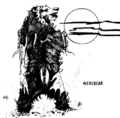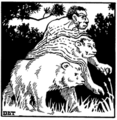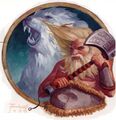Werebear: Difference between revisions
1d4chan>Nubnuber No edit summary |
m (20 revisions imported) |
||
| (8 intermediate revisions by 5 users not shown) | |||
| Line 1: | Line 1: | ||
[[File:Werebear 5e.png|right|300px]] | [[File:Werebear 5e.png|right|300px]] | ||
| Line 10: | Line 9: | ||
In [[Dungeons & Dragons]], the werebear is one of the few [[Alignment|Good]] [[therianthrope]]s, with the only other one being the [[Wereraven]]. Perhaps due to this, they are one of the "core" therianthropes, and have appeared in the [[Monster Manual]] for virtually every single edition, ever since their debut in The White Box in 1974. The only exception is [[Dungeons & Dragons 4th Edition]], where werebears never appeared as a monster at all - in keeping with the edition's philosophy that monsters should be at least Unaligned by default, rather than waste page space on Good monsters your party would probably never actually fight. Instead, due to choosing not to rework werebears as an Unaligned creature the way that [[Metallic Dragon]]s were, werebears were preserved and thusly only appeared as a PC template in 4th edition (see below). | In [[Dungeons & Dragons]], the werebear is one of the few [[Alignment|Good]] [[therianthrope]]s, with the only other one being the [[Wereraven]]. Perhaps due to this, they are one of the "core" therianthropes, and have appeared in the [[Monster Manual]] for virtually every single edition, ever since their debut in The White Box in 1974. The only exception is [[Dungeons & Dragons 4th Edition]], where werebears never appeared as a monster at all - in keeping with the edition's philosophy that monsters should be at least Unaligned by default, rather than waste page space on Good monsters your party would probably never actually fight. Instead, due to choosing not to rework werebears as an Unaligned creature the way that [[Metallic Dragon]]s were, werebears were preserved and thusly only appeared as a PC template in 4th edition (see below). | ||
The D&D werebear is a nature-loving solitary creature, typically dwelling in a cabin deep in the wilderness somewhere - preferably a deep temperate forest or taiga near well-stocked waters, with the whole territory averaging 1-4 | The D&D werebear is a nature-loving solitary creature, typically dwelling in a cabin deep in the wilderness somewhere - preferably a deep temperate forest or taiga near well-stocked waters, with the whole territory averaging 1-4 square miles. Due to their territorial instincts and reliance on nature's bounty, werebears are natural game wardens, striving to maintain and protect their territory and its ecology from harm. They are omnivores, with a taste for honey, which they are known to brew into an extremely potent mead. Although friendly enough when not provoked, werebears prefer to be alone; they don't even form family units the way most werebeasts do, and instead, males and females simply mate when they feel in season - the closest they get to marriage is having a preferred lover that they will usually seek out first when they feel inclined to have sex. A female werebear produces 1 or 2 children, born as humans that don't gain the ability to shapeshift until they reach adolescence at the age of eight, whereupon their mother drives them off and goes looking for a mate to get pregnant again. Such newly independent young are discreetly guided and assisted by older werebears. | ||
Despite their apparent isolationism and rugged individualism, werebears have a sense of community. They never attack each other and aid any werebear threatened by another therianthrope species - most commonly [[werewolves]] and [[wererat]]s, whom they despise. Werewolves in particular loathe werebears and will often clash with them. | Despite their apparent isolationism and rugged individualism, werebears have a sense of community. They never attack each other and aid any werebear threatened by another therianthrope species - most commonly [[werewolves]] and [[wererat]]s, whom they despise. Werewolves in particular loathe werebears and will often clash with them. According to the [[Mystara]] book ''PC4: Night Howler'' Polar Werebears are bitter enemies of [[Wereseal]]s | ||
Werebears do not travel a great deal. Only the rare individual (usually young) can be coaxed into joining a band of adventurers. Werebears may join an adventuring group as guides, provided the money is right and the job is agreeable. For obvious reasons, werebears are not particularly materialistic; their treasures (assuming they have any) are usually limited to small, valuable commodities like gold, platinum, gems, and jewelry. Werebears rarely carry any treasure and instead hide it near their homes. They also collect scrolls, potions, and other magical items, often as fees or rewards for past services. Werebears destroy any magical items that specifically affect therianthropes or bears, since such items might be used against themselves. | Werebears do not travel a great deal. Only the rare individual (usually young) can be coaxed into joining a band of adventurers. Werebears may join an adventuring group as guides, provided the money is right and the job is agreeable. For obvious reasons, werebears are not particularly materialistic; their treasures (assuming they have any) are usually limited to small, valuable commodities like gold, platinum, gems, and jewelry. Werebears rarely carry any treasure and instead hide it near their homes. They also collect scrolls, potions, and other magical items, often as fees or rewards for past services. Werebears destroy any magical items that specifically affect therianthropes or bears, since such items might be used against themselves. | ||
| Line 30: | Line 29: | ||
<gallery> | <gallery> | ||
Werebear Greyhawk.png|Greyhawk Supplement | Werebear Greyhawk.png|Greyhawk Supplement | ||
Werebear 1e.png|1e | |||
Werebear PC4 1.jpg|PC4 | Werebear PC4 1.jpg|PC4 | ||
Werebear PC4 2.jpg | Werebear PC4 2.jpg | ||
Werecreatures PC4 1.jpg | Werecreatures PC4 1.jpg | ||
Werebear MM 2e.png|2e | |||
Werebear MCV1.jpg | |||
Werebear VRG.jpg|Van Richten's Guide to Werebeasts | Werebear VRG.jpg|Van Richten's Guide to Werebeasts | ||
Werewolf Wererat Werebear 3e.jpg|3e | Werewolf Wererat Werebear 3e.jpg|3e | ||
Werebear Wererat Dragon 410.jpg|4e | Werebear Wererat Dragon 410.jpg|4e | ||
Polarwere Dragon 266.jpg|Polarwere | Polarwere Dragon 266.jpg|Polarwere | ||
Werebear B2 PF.png|Pathfinder | |||
</gallery> | </gallery> | ||
{{D&D-Therianthropes}} | |||
[[Category: Monsters]] [[Category: Dungeons & Dragons]] [[Category: World of Darkness]] [[Category: Warhammer Fantasy]] [[Category:Therianthropes]] | [[Category: Monsters]] [[Category: Dungeons & Dragons]] [[Category: World of Darkness]] [[Category: Warhammer Fantasy]] [[Category:Therianthropes]] | ||
Latest revision as of 12:00, 23 June 2023

Werebears is a question you might be asked by an enthusiastic big game hunter with a speech impediment. They are also a species of therianthrope consisting of people who can turn into bears. It's not exactly a hard concept to grasp, and not entirely without some mythological precedent; the viking word "Baersark", a root word for "Berserk", literally means "Bearshirt", and Berserkers were often described as wearing bear-skin shirts (a symbol of how powerful they were), or even reputed to transformed into bears on the battlefield - as these same berserkers were also part of the heritage that gave us the more famous werewolf, tying werebears to them is not a major leap.
There was a race of them in Middle-Earth, though they're few in number by the time of The Hobbit with the most notable member being Beorn. Werebears are most associated with Dungeons & Dragons, where they are amongst the tiny number of naturally good therianthropes. They have also appeared in both Werewolf: The Apocalypse and Werewolf: The Forsaken. In Warhammer Fantasy, one of the Regiments of Renown are the Bearmen of Urslo, a tribe of Chaos Marauders gifted to varying extents with ursine transformation abilities and led by the Chaos Champion Beorg Bearstruck, a full-fledged Chaos-worshipping Werebear. Also, in at least some editions of Warhammer Fantasy, wizards using the Lore of Beasts can turn themselves into a werebear as one of the lore's more powerful buff spells.
D&D[edit]
In Dungeons & Dragons, the werebear is one of the few Good therianthropes, with the only other one being the Wereraven. Perhaps due to this, they are one of the "core" therianthropes, and have appeared in the Monster Manual for virtually every single edition, ever since their debut in The White Box in 1974. The only exception is Dungeons & Dragons 4th Edition, where werebears never appeared as a monster at all - in keeping with the edition's philosophy that monsters should be at least Unaligned by default, rather than waste page space on Good monsters your party would probably never actually fight. Instead, due to choosing not to rework werebears as an Unaligned creature the way that Metallic Dragons were, werebears were preserved and thusly only appeared as a PC template in 4th edition (see below).
The D&D werebear is a nature-loving solitary creature, typically dwelling in a cabin deep in the wilderness somewhere - preferably a deep temperate forest or taiga near well-stocked waters, with the whole territory averaging 1-4 square miles. Due to their territorial instincts and reliance on nature's bounty, werebears are natural game wardens, striving to maintain and protect their territory and its ecology from harm. They are omnivores, with a taste for honey, which they are known to brew into an extremely potent mead. Although friendly enough when not provoked, werebears prefer to be alone; they don't even form family units the way most werebeasts do, and instead, males and females simply mate when they feel in season - the closest they get to marriage is having a preferred lover that they will usually seek out first when they feel inclined to have sex. A female werebear produces 1 or 2 children, born as humans that don't gain the ability to shapeshift until they reach adolescence at the age of eight, whereupon their mother drives them off and goes looking for a mate to get pregnant again. Such newly independent young are discreetly guided and assisted by older werebears.
Despite their apparent isolationism and rugged individualism, werebears have a sense of community. They never attack each other and aid any werebear threatened by another therianthrope species - most commonly werewolves and wererats, whom they despise. Werewolves in particular loathe werebears and will often clash with them. According to the Mystara book PC4: Night Howler Polar Werebears are bitter enemies of Wereseals
Werebears do not travel a great deal. Only the rare individual (usually young) can be coaxed into joining a band of adventurers. Werebears may join an adventuring group as guides, provided the money is right and the job is agreeable. For obvious reasons, werebears are not particularly materialistic; their treasures (assuming they have any) are usually limited to small, valuable commodities like gold, platinum, gems, and jewelry. Werebears rarely carry any treasure and instead hide it near their homes. They also collect scrolls, potions, and other magical items, often as fees or rewards for past services. Werebears destroy any magical items that specifically affect therianthropes or bears, since such items might be used against themselves.
In the World Axis, werebears are divinely touched; individuals blessed by both Melora and the Primal Spirits who use their therianthropic might to safeguard the wilderness from the many dangers that threaten it, both from within and without. Most descend from ancient clans favored by these entities, but others are rangers, wardens, or simply the faithful of Melora who have been given the gift of bear-form as a reward for their devotion or as a way to better protect the wilderness. Because of this, whilst the werebears of the Nentir Vale world are often isolationistic like their Great Wheel counterparts, they have a notable minority who become adventurers.
Frost Giants are known to be susceptible to the werebear strain of therianthropy (alongside the seawolf strain), and also have their own strain of "true" lycanthropes; Giant Werepolar Bears, or simply "Polarweres". Unlike their smaller counterparts, these werebears are bitter, spiteful, selfish and malicious creatures who wish only to be left alone in total isolation and who regard anything they can take down as fit only for food. And a 20ft tall polar bear can take down a lotta things. In fact, it's implied that Polarweres are actually "beastweres" - sapient giant polar bears with the ability to change into Frost Giant forms - rather than therianthropic frost giants, because they actually revert to bear form when slain. Polarweres have only appeared in the article "Dragon's Bestiary: Giant Lycanthropes" in Dragon Magazine #266 for Advanced Dungeons & Dragons 2nd edition.
In Eberron, like all lycanthropes, werebears were also purged as part of the Silver Flame's crusade. This is because it's still literally a mind ravaging disease that destroys the original personality, even though it doesn't ping as "evil" like wererat or werewolf do. And the impetus for the purge was a flare-up in lycanthropic activity that was causing even the "good" werebears to become violent and dangerous.
Werebear PCs[edit]
Like many therianthropes, werebears have appeared as a PC option from time to time. They had a BECMI race-class in PC4: The Night Howlers, and in Advanced Dungeons & Dragons appeared as both a race (Dragon Magazine #24) and as a class (White Dwarf #17). In Dungeons & Dragons 3rd Edition, they had a racial class in Dragon Magazine #313, and in Dungeons & Dragons 4th Edition, they appeared for the only time in the edition as a PC Theme in Dragon Magazine #410.
Gallery[edit]
-
Greyhawk Supplement
-
1e
-
PC4
-
-
-
2e
-
-
Van Richten's Guide to Werebeasts
-
3e
-
4e
-
Polarwere
-
Pathfinder
| The Therianthropes of Dungeons & Dragons | |
|---|---|
| Therianthrope | Laridian • Loup-garou • Loup du Noir • Lythari • Red Falcon • Seawolf • Selkie • Shifter • Swanmay • Thebestyn • Vodoni • Werebaboon • Werebadger • Werebat • Werebear • Wereboar • Werecat • Werecrocodile • Werefox • Werehyena • Werejackal • Werejaguar • Werekillerwhale • Wereleopard • Werelion • Werepanther • Wererat • Wereraven • Wereray • Wereseal • Weresnake • Wereshark • Werespider • Wereswine • Weretiger • Werewalrus • Werewolf |
| Antherions | Aranea • Song Dragon • Jackalwere • Nawidnehr • Wolfwere |
| Third Party | Werealligator • Wereanaconda • Werebunny • Werecheetah • Werecobra • Weremustela • Wereoctopus • Werepossum • Wereraccoon • Werestag • Werewolverine |










